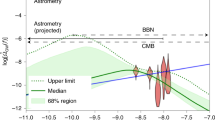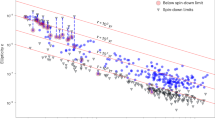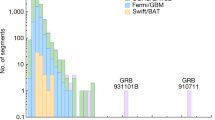Abstract
A stochastic background of gravitational waves is expected to arise from a superposition of a large number of unresolved gravitational-wave sources of astrophysical and cosmological origin. It should carry unique signatures from the earliest epochs in the evolution of the Universe, inaccessible to standard astrophysical observations1. Direct measurements of the amplitude of this background are therefore of fundamental importance for understanding the evolution of the Universe when it was younger than one minute. Here we report limits on the amplitude of the stochastic gravitational-wave background using the data from a two-year science run of the Laser Interferometer Gravitational-wave Observatory2 (LIGO). Our result constrains the energy density of the stochastic gravitational-wave background normalized by the critical energy density of the Universe, in the frequency band around 100 Hz, to be <6.9 × 10-6 at 95% confidence. The data rule out models of early Universe evolution with relatively large equation-of-state parameter3, as well as cosmic (super)string models with relatively small string tension4 that are favoured in some string theory models5. This search for the stochastic background improves on the indirect limits from Big Bang nucleosynthesis1,6 and cosmic microwave background7 at 100 Hz.
This is a preview of subscription content, access via your institution
Access options
Subscribe to this journal
Receive 51 print issues and online access
$199.00 per year
only $3.90 per issue
Buy this article
- Purchase on Springer Link
- Instant access to full article PDF
Prices may be subject to local taxes which are calculated during checkout





Similar content being viewed by others
References
Maggiore, M. Gravitational wave experiments and early universe cosmology. Phys. Rep. 331, 283–367 (2000)
Abbott, B. et al. Detector description and performance for the first coincidence observations between LIGO and GEO. Nucl. Instrum. Meth. A 517, 154–179 (2004)
Boyle, L. & Buonanno, A. Relating gravitational wave constraints from primordial nucleosynthesis, pulsar timing, laser interferometers, and the CMB: implications for the early universe. Phys. Rev. D 78, 043531 (2008)
Siemens, X., Mandic, V. & Creighton, J. Gravitational-wave stochastic background from cosmic strings. Phys. Rev. Lett. 98, 111101 (2007)
Sarangi, S. & Tye, S. H. H. Cosmic string production towards the end of brane inflation. Phys. Lett. B 536, 185–192 (2002)
Allen, B. The stochastic gravity-wave background: sources and detection. Preprint at <http://arXiv.org/abs/grqc/9604033> (1996)
Smith, T. L., Pierpaoli, E. & Kamionkowski, M. A new cosmic microwave background constraint to primordial gravitational waves. Phys. Rev. Lett. 97, 021301 (2006)
Allen, B. & Romano, J. Detecting a stochastic background of gravitational radiation: signal processing strategies and sensitivities. Phys. Rev. D 59, 102001 (1999)
Starobinskii, A. A. Spectrum of relict gravitational radiation and the early state of the universe. JETP Lett. 30, 682–685 (1979)
Bar-Kana, R. Limits on direct detection of gravitational waves. Phys. Rev. D 50, 1157–1162 (1994)
Brustein, R. et al. Relic gravitational waves from string cosmology. Phys. Lett. B 361, 45–51 (1995)
Buonanno, A. et al. Spectrum of relic gravitational waves in string cosmology. Phys. Rev. D 55, 3330–3336 (1997)
Mandic, V. & Buonanno, A. Accessibility of the pre-big-bang models to LIGO. Phys. Rev. D 73, 063008 (2006)
Apreda, R. et al. Gravitational waves from electroweak phase transitions. Nucl. Phys. B 631, 342–368 (2002)
Kibble, T. W. B. Topology of cosmic domains and strings. J. Phys. A 9, 1387–1398 (1976)
Damour, T. & Vilenkin, A. Gravitational radiation from cosmic (super)strings: bursts, stochastic background, and observational windows. Phys. Rev. D 71, 063510 (2005)
Regimbau, T. & de Freitas Pacheco, J. A. Gravitational wave background from magnetars. Astron. Astrophys. 447, 1–8 (2006)
Regimbau, T. & de Freitas Pacheco, J. A. Cosmic background of gravitational waves from rotating neutron stars. Astron. Astrophys. 376, 381–385 (2001)
Acernese, F. et al. Status of Virgo. Class. Quant. Grav. 25, 114045 (2008)
Willke, B. et al. The GEO-HF project. Class. Quant. Grav. 23, S207–S214 (2006)
Bennet, C. L. et al. First-year Wilkinson Microwave Anisotropy Probe (WMAP) observations: preliminary maps and basic results. Astrophys. J. 148 (Suppl.). 1–28 (2003)
Abbott, B. et al. Searching for a stochastic background of gravitational waves with the Laser Interferometer Gravitational-Wave Observatory. Astrophys. J. 659, 918–930 (2007)
Cyburt, R. H. et al. New BBN limits on physics beyond the standard model from 4He. Astropart. Phys. 23, 313–323 (2005)
Grishchuk, L. P. & Sidorov, Yu. V. Squeezed quantum states of relic gravitons and primordial density fluctuations. Phys. Rev. D 42, 3413–3421 (1990)
Advanced LIGO Team. Advanced LIGO reference design. LIGO preprint at <http://www.ligo.caltech.edu/docs/M/M060056-10.pdf> (2007)
Bender, P. L. & Danzmann, K. & the LISA study team . Laser Interferometer Space Antenna for the Detection and Observation of Gravitational Waves: Pre-Phase A Report 2nd edn (MPQ233, Max-Plank Institut für Quantenoptik, 1998)
Jenet, F. A. et al. Upper bounds on the low-frequency stochastic gravitational wave background from pulsar timing observations: current limits and future prospects. Astrophys. J. 653, 1571–1576 (2006)
Komatsu, E. et al. Five-year Wilkinson Microwave Anisotropy Probe (WMAP) observations: cosmological interpretation. Astrophys. J. 180 (Suppl.). 330–376 (2009)
Siemens, X. et al. Size of the smallest scales in cosmic string networks. Phys. Rev. D 66, 043501 (2002)
Siemens, X. et al. Gravitational wave bursts from cosmic (super)strings: quantitative analysis and constraints. Phys. Rev. D 73, 105001 (2006)
Acknowledgements
We acknowledge the support of the United States National Science Foundation for the construction and operation of the LIGO Laboratory, the Science and Technology Facilities Council of the United Kingdom, the Max Planck Society, and the State of Niedersachsen/Germany for support of the construction and operation of the GEO600 detector, and the Italian Istituto Nazionale di Fisica Nucleare and the French Centre National de la Recherche Scientifique for the construction and operation of the Virgo detector. We also acknowledge the support of the research by these agencies and by the Australian Research Council, the Council of Scientific and Industrial Research of India, the Istituto Nazionale di Fisica Nucleare of Italy, the Spanish Ministerio de Educacion y Ciencia, the Conselleria d'Economia Hisenda i Innovacio of the Govern de les Illes Balears, the Royal Society, the Scottish Funding Council, the Scottish Universities Physics Alliance, The National Aeronautics and Space Administration, the Carnegie Trust, the Leverhulme Trust, the David and Lucile Packard Foundation, the Research Corporation, and the Alfred P. Sloan Foundation.
Author Contributions are listed in Supplementary Information.
Author information
Authors and Affiliations
Consortia
Corresponding author
Additional information
Lists of participants and their affiliations appear at the end of the paper.
Supplementary information
Supplementary Information
This file contains Supplementary Methods, Supplementary Results, Supplementary Data and Supplementary Figures 1-7 with Legends. (PDF 398 kb)
Rights and permissions
About this article
Cite this article
The LIGO Scientific Collaboration & The Virgo Collaboration. An upper limit on the stochastic gravitational-wave background of cosmological origin. Nature 460, 990–994 (2009). https://doi.org/10.1038/nature08278
Received:
Accepted:
Issue Date:
DOI: https://doi.org/10.1038/nature08278
This article is cited by
-
The next detectors for gravitational wave astronomy
Science China Physics, Mechanics & Astronomy (2015)
-
Gravitational waves: search results, data analysis and parameter estimation
General Relativity and Gravitation (2015)
-
Observational results from the LIGO and Virgo detectors
General Relativity and Gravitation (2014)
-
Gravitational wave astronomy
Frontiers of Physics (2013)
Comments
By submitting a comment you agree to abide by our Terms and Community Guidelines. If you find something abusive or that does not comply with our terms or guidelines please flag it as inappropriate.



